Blackpool, Lancashire, England, UK – Tuesday, June 22nd, 2010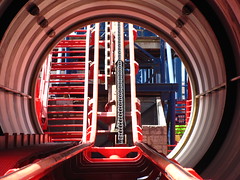
Where did the Pepsi Max Big One go wrong? It could have been beautiful. The first drop would stand 235 feet looking west over the Irish Sea, and the plunge that followed would be one of the most diabolically twisted sights in all of creation, and from there they were afforded the ability to build whatever their imaginations could conjure along the famous Blackpool promenade. The conclusion promised no less, a completely non-standard hypercoaster arrangement that would snake narrowly between and under Pleasure Beach’s assortment of classic rides and midways. It was devised right near the end of that short window in history after designers discovered the extremes they could go to but before they discovered the responsibility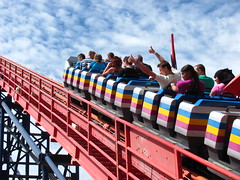 that came with pushing those boundaries. Its inspiration point, the Magnum XL-200, had aimed for the moon when it was an untested idea and somehow made it. The Big One reached further and had the advantage of three previous working examples to work from; it could have been assured that they would have gotten to Jupiter or beyond.
that came with pushing those boundaries. Its inspiration point, the Magnum XL-200, had aimed for the moon when it was an untested idea and somehow made it. The Big One reached further and had the advantage of three previous working examples to work from; it could have been assured that they would have gotten to Jupiter or beyond.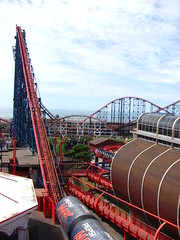
Even if the Arrow brand isn’t to every modern enthusiast’s taste, it should have at least been considered a classic in cult circles. The elegant retro-modernist station house with glass dome, bowed steel and oak walls, and vertically stacking transfer track, the cheesy faux-serious recorded voice describing Vertical Reality, the lift hill pouring out of a Pepsi can and that seems to keep on going up and up and up into the sky… all the right ingredients for a legend. Even today, you’ll still be climbing aboard the second tallest and longest roller coaster in the entire European continent; a place where designers admittedly tend towards the maxim that bigger does not always equate to better, but it doesn’t necessarily hurt, either. You’re sitting in the back row, listening to the rhythmic clunk-clunk-clunk-clunk-clunk of the chain dogs on the lift hill, the miniature models of historic Blackpool below you looking ever smaller, while the infinite expanse of hazy blue British seaside air above you appears ever larger; and all you can wonder is how much more time is left before you can see the cars ahead start to pull away.
oak walls, and vertically stacking transfer track, the cheesy faux-serious recorded voice describing Vertical Reality, the lift hill pouring out of a Pepsi can and that seems to keep on going up and up and up into the sky… all the right ingredients for a legend. Even today, you’ll still be climbing aboard the second tallest and longest roller coaster in the entire European continent; a place where designers admittedly tend towards the maxim that bigger does not always equate to better, but it doesn’t necessarily hurt, either. You’re sitting in the back row, listening to the rhythmic clunk-clunk-clunk-clunk-clunk of the chain dogs on the lift hill, the miniature models of historic Blackpool below you looking ever smaller, while the infinite expanse of hazy blue British seaside air above you appears ever larger; and all you can wonder is how much more time is left before you can see the cars ahead start to pull away.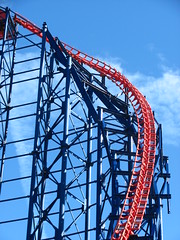
That initial drop of 213 feet will leave an impression on the first time rider, especially in the rear car. Perhaps that’s part of the problem, it makes too big of a first impression and everything else seems muted by comparison. Twisting first drops aren’t anything new, but Ron Toomer had a special way of making the simple so simple that it once again becomes difficult to understand. At 65 degrees you don’t need to bank the track much to achieve zero-laterals around a curve (indeed the concept of ‘banking track’ because less coherent as it approaches vertical). The benefit here is that the closer you’re operating in a zero G-force environment the easier it is to simply twist bodies around their center of gravity and the curvature comes naturally. Stengel perfected this on Expedition GeForce and used it to countless effect later on Intamin’s rocket coasters. Or, if you don’t like the calculus involved in rotating around a point, you can do as B&M do and simply trace part of a Golden Mean spiral, bank it as you would, and then angle it downhill, so it’s less of a ‘curving drop’ than it is a ‘dropping curve’.
 Neither of these approaches completely worked for Ronny so instead he made a chimera: have it descend nearly straight down along a near-vertical twist, but then bank it completely sideways anyway just to make sure any unwanted lateral g-forces have been completely killed. This also effectively murders any possible sensations of weightlessness, but that hardly matters because you’re essentially being whipped around onto your right side while falling straight down. I don’t want to know how many axes are required to plot the movement of the car through space on this drop, but whatever’s going on around this curve it happens very rapidly. Those on the right side of the train basically fall straight down while those on the left get pummeled around the outside of a curve despite being seated mere inches apart from each other, and both have to contend with criminal amounts of rotational torque. It may all prove too much, even I found that in the back row one or two slight bumps in the curvature became magnified to an uncomfortable degree.
Neither of these approaches completely worked for Ronny so instead he made a chimera: have it descend nearly straight down along a near-vertical twist, but then bank it completely sideways anyway just to make sure any unwanted lateral g-forces have been completely killed. This also effectively murders any possible sensations of weightlessness, but that hardly matters because you’re essentially being whipped around onto your right side while falling straight down. I don’t want to know how many axes are required to plot the movement of the car through space on this drop, but whatever’s going on around this curve it happens very rapidly. Those on the right side of the train basically fall straight down while those on the left get pummeled around the outside of a curve despite being seated mere inches apart from each other, and both have to contend with criminal amounts of rotational torque. It may all prove too much, even I found that in the back row one or two slight bumps in the curvature became magnified to an uncomfortable degree.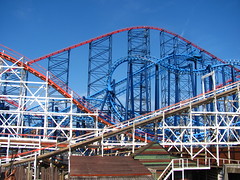
That drop alone required more words than I’ve ever dedicated to such an element, and more words than the entire layout that follows deserves. Everything after that drop is all very simple and shallow, worse than a Miss America finalist. The long ramp on the triangular second hill has echoes of Magnum’s dynamic bunny hops but without the dynamicism; the flat track only works because it has a clear ‘ending’ which should offer a form of payoff, but on the Big One you’re waiting to get to the top only to find that you’ve gone up too high to have any speed remaining, and so must regain it on another long ramp downhill. Normally I admire flat track on coasters. It can add rhythm between elements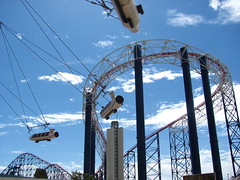 to fast paced rides and create dramatic tension in slower paced, theatrical rides. The Big One uses it for neither, the flat track becomes the foundational substance of the ride experience itself, and even if you’re not simply riding for forces but an entire multi-textural package it can’t shake the feeling that you’re rapidly going nowhere.
to fast paced rides and create dramatic tension in slower paced, theatrical rides. The Big One uses it for neither, the flat track becomes the foundational substance of the ride experience itself, and even if you’re not simply riding for forces but an entire multi-textural package it can’t shake the feeling that you’re rapidly going nowhere.
The far turnaround is better if only because of the sustained combination of height and speed, plus it’s a fascinating structure to look at especially when on top of it. The gigantic white lattice box structure bracing several singularly massive blue pillars, one of which had to be set further back than the rest to fit in the Grand National’s footprint and causes the track to ‘jump a corner’ of the bridge. The return run consists of three more broad triangular camelback hills which follow a zigzag pattern across to the other side of the park. This could have been made more interesting if the brief curves weren’t placed concurrently with the brief hill crests. The banked curvature cancels out any sense of weightlessness that might have been achieved at the crest, it would have worked so much better if the curves had been placed halfway up or down the ramps instead of at the tops and bottoms. Those that really enjoy height and speed will still probably find redeeming qualities in this first stretch of the Big One. It’s actually rather similar to Millennium Force in that regard, and arguably these sensations are even more accentuated on the Big One due to the rumbling shakiness of the vintage Arrow trains and track, or the absence of anything else of comparable height within miles.
camelback hills which follow a zigzag pattern across to the other side of the park. This could have been made more interesting if the brief curves weren’t placed concurrently with the brief hill crests. The banked curvature cancels out any sense of weightlessness that might have been achieved at the crest, it would have worked so much better if the curves had been placed halfway up or down the ramps instead of at the tops and bottoms. Those that really enjoy height and speed will still probably find redeeming qualities in this first stretch of the Big One. It’s actually rather similar to Millennium Force in that regard, and arguably these sensations are even more accentuated on the Big One due to the rumbling shakiness of the vintage Arrow trains and track, or the absence of anything else of comparable height within miles.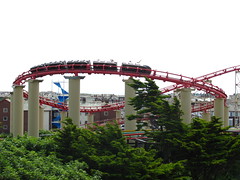
On the plus side, the midcourse brake never bit down too hard on any of my laps (likely owing to single train operation) so the second part of the ride was just as if not more fun than the first. Switching from the wide, drawn out hills, the layout takes on a mine coaster disposition and begins with a somewhat slow helix over the Steeplechase followed by some curving banked hops. The best part is a sudden curving drop between wooden coaster and ornamental structures into a narrow tunnel. The bottom of this is the most forceful part of the entire ride after the first drop, and the rise into the brake run that follows maintains a bit of punchiness with a minor slide to the right just before coming to a stop. Not much, but at least it ends on a relatively high note.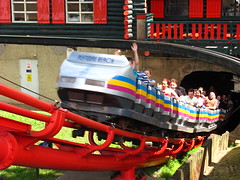
The third time riding it is the most frustrating. That’s when I was no longer first figuring out the ride that had always been seen from a distance and was now thinking about the better coaster it wasn’t. They could have fit a profile identical to Magnum’s out run in the space taken up by the first triangular summit, they could have given the return run a funky turn-crest-turn-dip-repeat rhythm if they didn’t put the turns at the tops of the crests, the last leg could have made an even stronger statement if they were willing to build the helix closer to the ground and with sharper dynamics in the track between there and the final tunnel. None of this was beyond Arrow’s abilities, in fact given their portfolio this version of the Big One might have been even more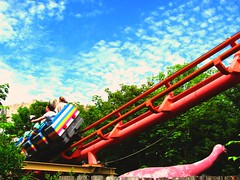 reasonably expected than the version we actually got. Maybe with limited computing abilities it simply became too much for Ron Toomer to take on at that point in his career and so simplified everything as much as possible to the point that it would still look like a roller coaster to those on the ground who never actually ride it (such as Toomer himself).
reasonably expected than the version we actually got. Maybe with limited computing abilities it simply became too much for Ron Toomer to take on at that point in his career and so simplified everything as much as possible to the point that it would still look like a roller coaster to those on the ground who never actually ride it (such as Toomer himself).
On later rerides I stopped focusing so much on the roller coaster the Big One wasn’t and started simply experiencing the roller coaster it was. When the pretenses of grandeur were laid aside and thoughts of ranking relative to other coasters ceased as a concern, there was an indelible pleasure remaining in the simple fact that in this moment in history I am alive to feel the rush of wind across my skin while peering down high above the boardwalk. The Big One is too mundane to ever be a great ride but in the end I resolved that that wasn’t sufficient reason to enjoy it any less. Revel in the fact that nothing much is going to happen for the next few minutes. One day we’re going to be out of time and wonder why we looked down and sneered so much on those two minutes we had with the Big One.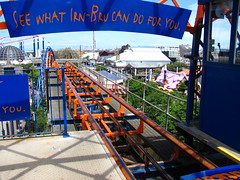
The Irn Bru Revolution is an equally simplistic roller coaster as the Pepsi Max Big One, with a similarly funky steel frame station and support structure… and soft drink sponsorship. However, this one invariably yields greater results per marginal length between crossties. It’s a bit of a hike to the upper platform that this Arrow shuttle loop begins from, but once up there, the great views are distracted exclusively by an even greater ride. Sit in the furthest extreme of the short four-carriage train as possible, preferably the very front, as the airtime over the curvatures of each hill are what make this as thrilling an attraction as the competing ground-level models by Anton Schwarzkopf (and it also justifies the climb of stairs). The reason I mention the front, apart from the clear view of the track ahead (which includes wondering how close to the edge you’ll get before the brakes slam on) is that the return drop-off is quite a turbulent shock going backwards. The centerpiece vertical loop, ostensibly why this ride ever existed in the first place, would be nearly forgotten if it too didn’t prove a potent positive G-force concoction.
ground-level models by Anton Schwarzkopf (and it also justifies the climb of stairs). The reason I mention the front, apart from the clear view of the track ahead (which includes wondering how close to the edge you’ll get before the brakes slam on) is that the return drop-off is quite a turbulent shock going backwards. The centerpiece vertical loop, ostensibly why this ride ever existed in the first place, would be nearly forgotten if it too didn’t prove a potent positive G-force concoction.
A mostly unrelated note, I’ve never had Irn Bru (pronounced “Iron Brew” and not “Earn Brew”, I later learned) before coming to the UK, but after trying my first bottle I got hooked on the stuff whenever tasked with ordering a non-alcoholic beverage. Mostly because the neon orange liquid was quite unlike any flavor I’ve ever tasted before or since and wanted to get my fill before returning to the States… apparently it couldn’t get FDA approval without changes to the formula.
 Of Arrow’s three roller coaster contributions to Blackpool, the Steeplechase is undoubtedly the most special. Built in 1977 as a throwback to the old Steeplechase rides once popular at Coney Island and other parks at the turn of the century, the reborn concept never caught on after being sold here and at Knott’s, leaving the Steeplechase as the only ride of its kind left in the world. The three tracks make this the only triple-racing coaster left in existence, although for some reason Blackpool seemed to have not realized that the racing aspect is what makes the experience worth riding and ran only single track operations both days I was there (they did alternate between running the green and red tracks, leaving me in a quandary
Of Arrow’s three roller coaster contributions to Blackpool, the Steeplechase is undoubtedly the most special. Built in 1977 as a throwback to the old Steeplechase rides once popular at Coney Island and other parks at the turn of the century, the reborn concept never caught on after being sold here and at Knott’s, leaving the Steeplechase as the only ride of its kind left in the world. The three tracks make this the only triple-racing coaster left in existence, although for some reason Blackpool seemed to have not realized that the racing aspect is what makes the experience worth riding and ran only single track operations both days I was there (they did alternate between running the green and red tracks, leaving me in a quandary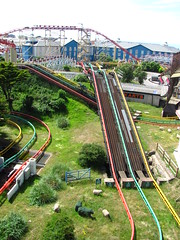 as to whether to count it as two or one coasters).
as to whether to count it as two or one coasters).
The enjoyability of the ride therefore came more from the curiosity of the mechanical construction than from the experience itself. To accommodate the three tracks in the station you have to enter overhead by a bridge and then follow a narrow lane down to the platform level between tracks before mounting your chosen steed. The seating is a bit awkward with nearly no restraining devices to speak of (nothing that wouldn’t prevent you from climbing off mid-ride if you so chose to), but despite the hard metal saddle the ergonomics were more palatable than Vekoma’s recent motorbike solution that forces one into a ‘riding’ position; here the rider is free to sit upright (and fall off) or lean forward (and smash their chin on the mane on an unexpected dip) without restriction. The layout is gentle although decently long, a dash around bends and over ‘hurdles’, set above the nearby hedge maze, featuring two short lift hills each followed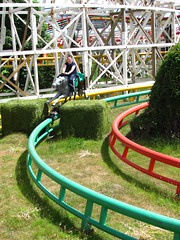 by a breezy downhill run. The block brakes are their own curiosity, singular clamps located at odd intervals along the layout that seem alone not enough to bring the artificial equine to a halt, so I had to wonder if two block segments were really required between horses. I don’t even want to try to describe the mechanisms operating below the horse that keeps it rolling upright along the single rail track, not that significant time on-ride was not devoted to the pursuit.
by a breezy downhill run. The block brakes are their own curiosity, singular clamps located at odd intervals along the layout that seem alone not enough to bring the artificial equine to a halt, so I had to wonder if two block segments were really required between horses. I don’t even want to try to describe the mechanisms operating below the horse that keeps it rolling upright along the single rail track, not that significant time on-ride was not devoted to the pursuit.
The biggest fault of the Steeplechase I found was that Arrow showed limited mastery over smoothly transitioning between straight track and turn, resulting in a ride sensation that, if not jarring, felt a little more unpredictable than our precarious position atop the slender, unsecured vehicles should have allowed. Regardless of whatever shortcomings it had, provided one could experience it with the “synchronize adjacent station platforms” button checked off, I would not hesitate to rank the Steeplechase as one of the top five reasons one should visit Blackpool in their lifetime (assuming, perhaps erroneously, that it will continue to be around for the rest of our lifetimes).
 Somehow Pleasure Beach manages to have one of the largest collections of roller coasters in Europe, yet few of these coasters are considered ‘staple’ categories that any big park shouldn’t feel complete without. One of the last on my to-do list is another relatively rare bird (coming from American sensibilities, at least), the Mack Bobsled roller coaster the Avalanche. This actually marked the third such ride I’d try after King’s Dominion’s and Europa Park’s, and I have to say that if there’s promise in the idea the execution still feels lacking to me. Simply put, they’re too short. The ride profile seems similar in nature to a mine train or suspended coaster, but these always lack the meandering, multi-part layouts that I associate
Somehow Pleasure Beach manages to have one of the largest collections of roller coasters in Europe, yet few of these coasters are considered ‘staple’ categories that any big park shouldn’t feel complete without. One of the last on my to-do list is another relatively rare bird (coming from American sensibilities, at least), the Mack Bobsled roller coaster the Avalanche. This actually marked the third such ride I’d try after King’s Dominion’s and Europa Park’s, and I have to say that if there’s promise in the idea the execution still feels lacking to me. Simply put, they’re too short. The ride profile seems similar in nature to a mine train or suspended coaster, but these always lack the meandering, multi-part layouts that I associate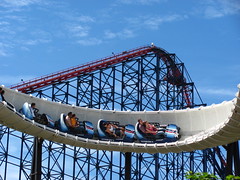 with those other family thrill rides. I liked Europa Park’s version a bit better because there was much greater variety and was long enough for at least one midcourse block brake, although Europa requires a much more insane hourly throughput than Blackpool ever does: on the German sleds I waited nearly thirty minutes because the queue was that big despite three train operation; on the British sleds I waited nearly thirty minutes because they had to turn all the cars inside out and walk the trough after a gentleman reported losing his glasses, only to remember he had put them in his wife’s purse all along.
with those other family thrill rides. I liked Europa Park’s version a bit better because there was much greater variety and was long enough for at least one midcourse block brake, although Europa requires a much more insane hourly throughput than Blackpool ever does: on the German sleds I waited nearly thirty minutes because the queue was that big despite three train operation; on the British sleds I waited nearly thirty minutes because they had to turn all the cars inside out and walk the trough after a gentleman reported losing his glasses, only to remember he had put them in his wife’s purse all along.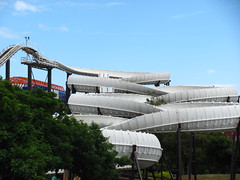
That said if there was one thing I liked about Blackpool’s Avalanche over other versions was that its directness did build an intensity not found on its rivals. Straight from the lift there’s a series of uniform back-and-forth S-curves leading straight back down to the bottom, and the repetition combined with increasing speed resulted in a few moments of genuine accumulated excitement towards the end. A full helix as the finale works contrary to the intended effect, slowing the pace of rapid switchbacks down and ending more demur than it probably could have, although as it barely lasts thirty seconds from lift to brakes anyway talk of dramatic layout progression seems a bit trivial in this context.
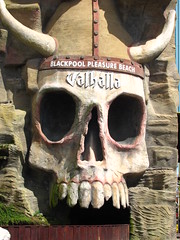 In terms of misfit attractions, Valhalla probably takes the cake out of all the oddities found in Pleasure Beach, which could probably be a different way of saying it fits in perfectly. It has a bigger themeing budget than Universal in a park distinguished for having no cohesive presentation, is one of the world’s wettest water attractions in the one corner of the earth the sun is least likely to be seen, and (most surprisingly) it’s an intentionally great ride where any other ride around it achieved greatness only by happy chance. The decision that I would ride was obvious long before I set foot in England, but it took some deliberations over when and how to deal with the soaking factor in the moderate climate before electing to wait until the warmest part of the afternoon on the second day and buy a £1 plastic rain poncho which I would use consecutively several times before discarding it forever.
In terms of misfit attractions, Valhalla probably takes the cake out of all the oddities found in Pleasure Beach, which could probably be a different way of saying it fits in perfectly. It has a bigger themeing budget than Universal in a park distinguished for having no cohesive presentation, is one of the world’s wettest water attractions in the one corner of the earth the sun is least likely to be seen, and (most surprisingly) it’s an intentionally great ride where any other ride around it achieved greatness only by happy chance. The decision that I would ride was obvious long before I set foot in England, but it took some deliberations over when and how to deal with the soaking factor in the moderate climate before electing to wait until the warmest part of the afternoon on the second day and buy a £1 plastic rain poncho which I would use consecutively several times before discarding it forever.
The Norse mythological inspiration is darker than most themed rides, and the absence of any tie-in franchise frees the need from following a central character through a standard-issue theme park ride storyline (“Omigod something has gone wrong again!”), instead suggesting a Homeric odyssey across a variety of times and places. After boarding our four-row vessel we set sail through the mouth of a giant skull, the waterfall overhead turning off just before we pass beneath (not that staying dry here does anything to delay the inevitable). An absurd number of special effects await within the stygian river caverns, but I found the most effective were when they forwent crafting a detailed animatronic diorama and instead let the fog or darkness take over the imagination, the rider’s mind doing more creative work than the designers could ever hope to achieve through practical sets. Particularly effective were portions of the story where we slowly moved past a thick wall of fog with yellow backlighting suggesting some unseen primordial spectacle just out of sight, or a claustrophobic journey down an ice crevice with waves of water along the flume from some unseen force compelling us forward.
a Homeric odyssey across a variety of times and places. After boarding our four-row vessel we set sail through the mouth of a giant skull, the waterfall overhead turning off just before we pass beneath (not that staying dry here does anything to delay the inevitable). An absurd number of special effects await within the stygian river caverns, but I found the most effective were when they forwent crafting a detailed animatronic diorama and instead let the fog or darkness take over the imagination, the rider’s mind doing more creative work than the designers could ever hope to achieve through practical sets. Particularly effective were portions of the story where we slowly moved past a thick wall of fog with yellow backlighting suggesting some unseen primordial spectacle just out of sight, or a claustrophobic journey down an ice crevice with waves of water along the flume from some unseen force compelling us forward.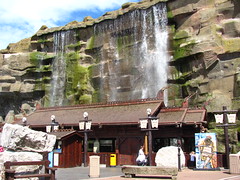
It helps that we’re already fearful of the prospect of pain and death, although in lieu of actual torture both ride and riders mutually agree to let ‘wetness’ stand in as a metaphor for these far greater horrors. Hence, we know that ‘death’ is inevitable and imminent (we’re virtually swimming in it), but we seem capable of escaping it in the short-term; the prospect of venturing into the unknown, towards something we can’t yet see, is when the ride is at its most effective. If Valhalla were designed like an American water ride where you get water dumped upon you around the first corner than the whole psychological tension would be lost and the rest of the ride would be a lame duck. I couldn’t particularly care for those sets which are contained within themselves unless they threatened hidden squirt fountains from some unknown source, because after all what is there for me to fear once we’ve moved on? The ice chamber may have been the most interesting of these stand-alone sets if it had been working properly with the promised snow effects and didn’t just feel like we stepped into our grandma’s house with the AC on after playing outside in the summer.
Three drops are present: the first is effective because it’s taken backwards so you can’t see where you’re going, you can only brace yourself under your poncho and hope for the best. It turns out to be a very shallow drop with minimal splash at the bottom, and we feel simultaneously relieved and anxious over retaining our precariously dry being for the next set of dangers. The second drop (forward) is a big one and it is a real soaker. I guess that’s what makes the rain ponchos a mixed blessing, we emerge from that drop wet but not soaked through and through like everyone else, so we can’t simply accept the fact that now we’ve been totally ‘killed’ so we can sit back and soak in the rest of the pleasures our afterlife in Valhalla has in store.
The third drop is just as big as the second with a double dip; moments before going over the edge I clenched my poncho tight over all potentially exposed articles of clothing and told myself that if I could make it through this one I had almost surely made it home safe. Perched in the front row on the precipice of this ultimate plunge, I should make a quick contextual clarification by reminding you that a themed object or effect in-itself is of very little importance to me; I’m always looking for what is subjectively real about a given experience, often that’s g-forces or the visceral experience of a roller coaster, but in a case like Valhalla it’s getting wet when I don’t really want to. That’s not to say that those earlier scene rooms do nothing, indeed they are essential narrative enablers to achieving a proper state of psychological fear. Much like a great theatrical stage play, for all its obvious fakeness, it feels incredibly powerful when we arrive at a climax that says something important to us about our own condition. But in the wet dark ride, at the moment I’m pushed to that very edge, I don’t care if the greatest audio-animatronic creation is roaring overhead (ahem, Jurassic Park), I’m focused on what I know has real consequences for me.
Down we plunge into the abyss, and just as the boat starts to level out for the splashdown there’s a special effect at the bottom that catches my attention. In fact, it’s so special that it completely wrenches my attention away from my impending ‘death’ and for a moment made me seriously question whether an authentic Death was imminent. Covering the pool of water in the splashdown reservoir, including directly over the path our boat will be traversing, is a gigantic fucking fireball. This is not some visual effect projected on a smoke screen; they literally covered the entire pool of water with gasoline and set it ablaze, resulting in some SUV-sized pillars of flaming death for us to merrily jump through.
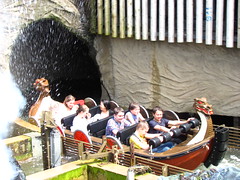 If it’s not already obvious I am a total wimp that always looks at people who extinguish candles with their licked fingers like they’re batshit insane so I guess my reaction would have been expected here, but I would expect many people besides me to have been, um, startled by what appeared to be a very real threat. It doesn’t matter that it’s “theme park fire”, so long as its fire, it’s still gonna burn. They could fake flames but they can’t fake heat, that much you know is always real. Thankfully we make it through safely by virtue of the splashing water displaced by our boat carving out a path through the flames before clearing the other side and diving all the way in for the big, drenching splashdown. At that moment I was happy to be soaked.
If it’s not already obvious I am a total wimp that always looks at people who extinguish candles with their licked fingers like they’re batshit insane so I guess my reaction would have been expected here, but I would expect many people besides me to have been, um, startled by what appeared to be a very real threat. It doesn’t matter that it’s “theme park fire”, so long as its fire, it’s still gonna burn. They could fake flames but they can’t fake heat, that much you know is always real. Thankfully we make it through safely by virtue of the splashing water displaced by our boat carving out a path through the flames before clearing the other side and diving all the way in for the big, drenching splashdown. At that moment I was happy to be soaked.
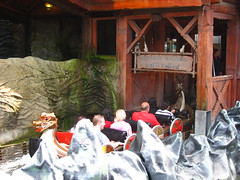 And really, the poncho did its job and kept me from getting too wet (provided I kept my shoes off the floor after some of the splashdowns when the boats would be momentarily flooded), enough that I went around and rode it three time in a row, with plenty more tricks and effects to discover on each time. Apparently there were many more surprises found along the original ride that opened in 2000, but many of these have been removed over time as, predictably, the attraction is too big and complex to keep in working order after long periods of time. Even in its present condition, it’s one of the few purely themed attractions to have left an impression on me that’s as strong as a really good roller coaster experience, which I didn’t merely write off as cute folly, but as something worth closer examination.
And really, the poncho did its job and kept me from getting too wet (provided I kept my shoes off the floor after some of the splashdowns when the boats would be momentarily flooded), enough that I went around and rode it three time in a row, with plenty more tricks and effects to discover on each time. Apparently there were many more surprises found along the original ride that opened in 2000, but many of these have been removed over time as, predictably, the attraction is too big and complex to keep in working order after long periods of time. Even in its present condition, it’s one of the few purely themed attractions to have left an impression on me that’s as strong as a really good roller coaster experience, which I didn’t merely write off as cute folly, but as something worth closer examination.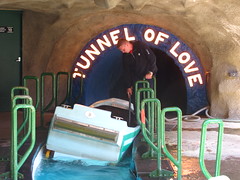 If Valhalla were located in Orlando we would not stop hearing about it in polls and online discussion, yet tucked away in gloomy Lancashire it seems it will have to settle for urban legend status among the majority of theme park aficionados.
If Valhalla were located in Orlando we would not stop hearing about it in polls and online discussion, yet tucked away in gloomy Lancashire it seems it will have to settle for urban legend status among the majority of theme park aficionados.
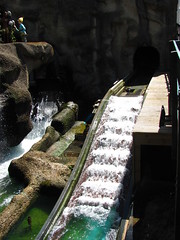 This is not to give short shrift to Pleasure Beach’s other dark rides, for what they lack in grandeur compared to Valhalla they make up for in character. The River Caves (also apparently known as the Tunnel of Love) is arguably a mini proto-Valhalla. A slow indoor flume past historical and mythological dioramas demonstrates perfectly How Dark Rides Used To Be Made; self-serious before they became cute and kitschy as most ‘classic’ dark rides are, before they became self-serious again in the age of big budget destination resorts. The opening date of 1905 would confirm this: it is firmly in leagues with the original Coney Island attractions which were used almost as much as historical education as they were for entertainment. A splashdown drop not much taller than an average elementary school student finishes the proceedings.
This is not to give short shrift to Pleasure Beach’s other dark rides, for what they lack in grandeur compared to Valhalla they make up for in character. The River Caves (also apparently known as the Tunnel of Love) is arguably a mini proto-Valhalla. A slow indoor flume past historical and mythological dioramas demonstrates perfectly How Dark Rides Used To Be Made; self-serious before they became cute and kitschy as most ‘classic’ dark rides are, before they became self-serious again in the age of big budget destination resorts. The opening date of 1905 would confirm this: it is firmly in leagues with the original Coney Island attractions which were used almost as much as historical education as they were for entertainment. A splashdown drop not much taller than an average elementary school student finishes the proceedings.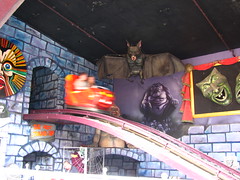
Relatively more recent entries to the genre include the Ghost Train, an amusing romp that might prove a dilemma for some coaster counters who use “gravity driven” as the necessary and sufficient criteria in determining was is and isn’t a coaster, and Alice in Wonderland. If one is to be considered required riding while in Blackpool it should be the latter. Despite a theme that would suggest it as intended “for kids”, the ride manages to feel not so much a rip-off of the Disney version but rather a return of the story to its English roots (minus the music swiped from Willy Wonka, for some unknown reason), plus classic dark ride fans who cherish the electric hum of buggy cars, the bang of cheap wooden chamber doors thrust open, and the hiss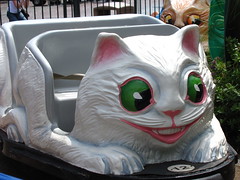 of pneumatic pistons triggering handpainted Day-Glo props will find plenty to savor in this ride’s long layout (ending with a strange outdoor section which takes nearly a minute to slowly curlicue back and forth down to the station platform level). The story doesn’t make much sense as you motor past partially unlit scenes presumably inspired by the book, but it’s all hallucinogenic enough that it shouldn’t really matter.
of pneumatic pistons triggering handpainted Day-Glo props will find plenty to savor in this ride’s long layout (ending with a strange outdoor section which takes nearly a minute to slowly curlicue back and forth down to the station platform level). The story doesn’t make much sense as you motor past partially unlit scenes presumably inspired by the book, but it’s all hallucinogenic enough that it shouldn’t really matter.
The Blackpool Derby Racer was a special ride to me, being one of only two other places in the world where I could ride a version of Prior and Church’s high-speed racing carousels outside of the iconic ride at my home park in Ohio. Although built by the same people, after nearly 90 years of service the carousels have evolved into quite different experiences. The Cedar Downs is rather focused on the unique high-speed racing that distinguishes
rather focused on the unique high-speed racing that distinguishes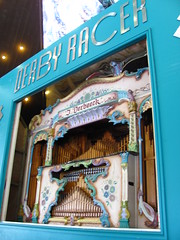 it from other rides, a sparse emphasis on decorative ornamentation and the customary music replaced with a recording of a derby announcer calling a race. Blackpool’s, on the other hand, was beautifully presented beneath a detailed canopy with an elaborate centerpiece in the middle of the ring, and best of all a fully operating calliope organ at the back pumping out a merry assortment of tunes. The downside was a slower turntable speed and disabled was the mechanism allowing the horses to jockey back and forth for position. I suppose I shall have to venture to Rye Playland one of these day to see if their version combines the best features of Cedar Point’s and Blackpool’s.
it from other rides, a sparse emphasis on decorative ornamentation and the customary music replaced with a recording of a derby announcer calling a race. Blackpool’s, on the other hand, was beautifully presented beneath a detailed canopy with an elaborate centerpiece in the middle of the ring, and best of all a fully operating calliope organ at the back pumping out a merry assortment of tunes. The downside was a slower turntable speed and disabled was the mechanism allowing the horses to jockey back and forth for position. I suppose I shall have to venture to Rye Playland one of these day to see if their version combines the best features of Cedar Point’s and Blackpool’s.
 As the shadows grew longer on my second day and my awareness of time became more acute I found myself drawn to staying put on two rides, one of which was the incomparable Wild Mouse. Since I didn’t want the operator to think me insane after more than five laps in a row, the second attraction I would rotate with was the Grand National. Like many of the other historical attractions at Pleasure Beach, this one has a “one of” tag attached to its reputation, in this case: “one of only three mobius racing roller coasters in the world.” Perhaps an overused factoid that needs no repeating for the majority of my readers, but nevertheless it seems important to mention to fully and honestly describe the Grand Nash.
As the shadows grew longer on my second day and my awareness of time became more acute I found myself drawn to staying put on two rides, one of which was the incomparable Wild Mouse. Since I didn’t want the operator to think me insane after more than five laps in a row, the second attraction I would rotate with was the Grand National. Like many of the other historical attractions at Pleasure Beach, this one has a “one of” tag attached to its reputation, in this case: “one of only three mobius racing roller coasters in the world.” Perhaps an overused factoid that needs no repeating for the majority of my readers, but nevertheless it seems important to mention to fully and honestly describe the Grand Nash.
Mechanically, it is the most ‘normal’ wooden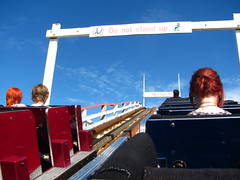 roller coaster in Blackpool, without nearly as many quirks of pre-computerized engineering as found on the Big Dipper or Wild Mouse. It makes up for this with a longer and more complete layout, with a progression of elements that seems simple on the surface but in fact must have been painstakingly labored over to tell a compelling ‘race story’. It alternates between the fast-paced moments of airtime drops and hills in which the trains more or less hold their positions, and slow-paced moments of bookend turns in which one train advances with respect to the other. The pacing of both of these sections generally becomes tighter and more frequently alternating as the finishing line draws nearer… until it reaches within sight, that is, in which this alternating sequence is abandoned for a mad, linear dash over pocket-sized bunny hops with riders
roller coaster in Blackpool, without nearly as many quirks of pre-computerized engineering as found on the Big Dipper or Wild Mouse. It makes up for this with a longer and more complete layout, with a progression of elements that seems simple on the surface but in fact must have been painstakingly labored over to tell a compelling ‘race story’. It alternates between the fast-paced moments of airtime drops and hills in which the trains more or less hold their positions, and slow-paced moments of bookend turns in which one train advances with respect to the other. The pacing of both of these sections generally becomes tighter and more frequently alternating as the finishing line draws nearer… until it reaches within sight, that is, in which this alternating sequence is abandoned for a mad, linear dash over pocket-sized bunny hops with riders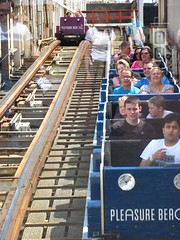 in both trains frenziedly yelling and bucking at their coaches in an effort to get whatever fraction of additional momentum is necessary to procure a nose-length’s lead at the finish line. All the excitement of a real race, but the riders are the jockeys and this half-mile features some rather extreme double-dips!
in both trains frenziedly yelling and bucking at their coaches in an effort to get whatever fraction of additional momentum is necessary to procure a nose-length’s lead at the finish line. All the excitement of a real race, but the riders are the jockeys and this half-mile features some rather extreme double-dips!
That was the coaster I suspect most local fans are familiar with when they vote the Grand National to the top of many coaster polls and the one I really wanted to ride. Sadly I seem to have gotten to it on a bad week, as the two trains running the circuit showed wildly different temperaments. Blue was ferociously fast and always took the lead by the first turn regardless of dispatch timing, with airtime so extreme on some drops it hurt. Magenta, on the other hand, seemed resigned to always being the dark horse and never even tried. So slow did it track that barely any airtime was felt over even the sharper hills. By the time they reached the final leg, regardless of which side of the track they were racing, blue was always diving under the midway back to the station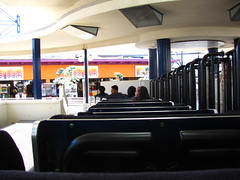 before magenta had even managed to round the previous bend. Thus the thrill of racing was lost, as well as most of the force for the magenta riders. So pronounced was this imbalance that it hardly required a coaster nerd to spot; even though the trains flipped sides each time, guests on the loading platform would always figure out where blue would be returning to before queuing and fill those rows before nearly anyone would resort to magenta. Since as a rerider I had the disadvantage of having to circle around the exit and entrance after the trains arrived, this generally meant I had last pickings and so was forced to find the smaller pleasures that taking Place had to offer.
before magenta had even managed to round the previous bend. Thus the thrill of racing was lost, as well as most of the force for the magenta riders. So pronounced was this imbalance that it hardly required a coaster nerd to spot; even though the trains flipped sides each time, guests on the loading platform would always figure out where blue would be returning to before queuing and fill those rows before nearly anyone would resort to magenta. Since as a rerider I had the disadvantage of having to circle around the exit and entrance after the trains arrived, this generally meant I had last pickings and so was forced to find the smaller pleasures that taking Place had to offer.
No doubt that the Grand National was a fine choice to make my official Last Ride at Blackpool among a selection of attractions as varied as any I’d likely find anywhere on the planet. With few crowds on the June weekdays I felt neither cheated short nor overloaded with time. There was always something else to explore or experience again that it never got old or redundant, but after two days when it became time to catch my train to Stoke-on-Trent, few regrets were felt upon leaving. Regardless of what the present management thinks is right for the future of Pleasure Beach, it will take a lot more than a few poorly imagined redevelopments to rob it of that special vibe that manages to be simultaneously one of the most exciting and yet also laid-back amusement parks in the world. In that way Blackpool Pleasure Beach lived up to my longstanding expectations.
among a selection of attractions as varied as any I’d likely find anywhere on the planet. With few crowds on the June weekdays I felt neither cheated short nor overloaded with time. There was always something else to explore or experience again that it never got old or redundant, but after two days when it became time to catch my train to Stoke-on-Trent, few regrets were felt upon leaving. Regardless of what the present management thinks is right for the future of Pleasure Beach, it will take a lot more than a few poorly imagined redevelopments to rob it of that special vibe that manages to be simultaneously one of the most exciting and yet also laid-back amusement parks in the world. In that way Blackpool Pleasure Beach lived up to my longstanding expectations.
Comments